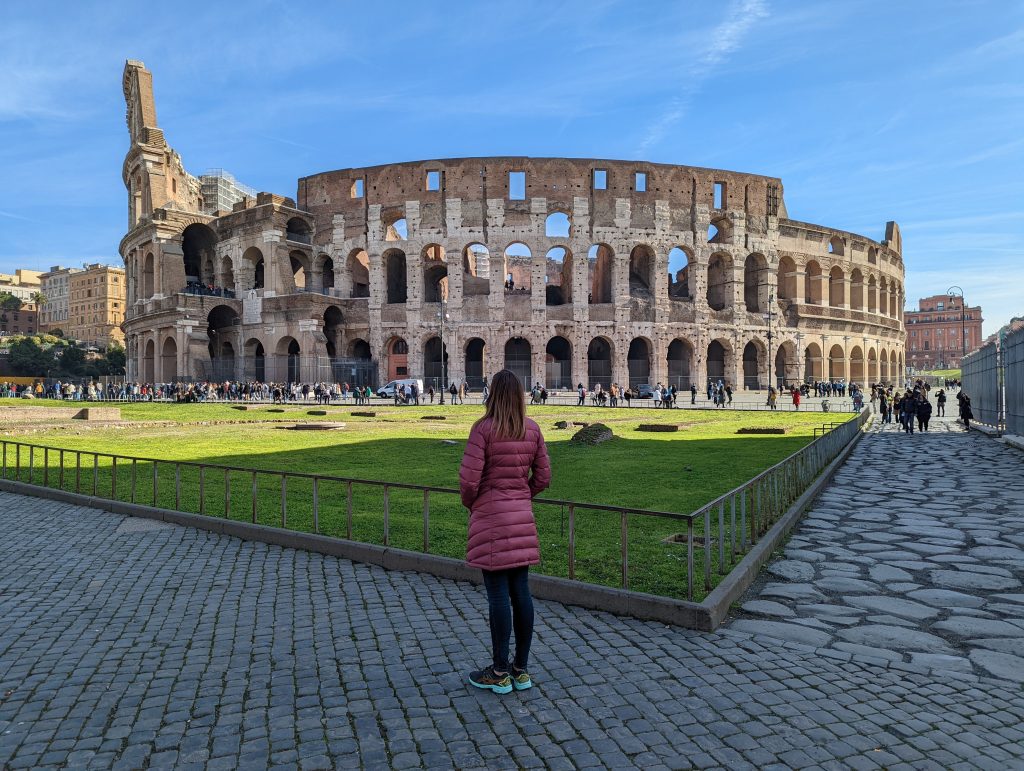We traveled to Rome, Italy in February 2022. There are so many things to consider and research that it might not seem worth traveling internationally (or at all) when COVID is a factor. However, if you feel safe traveling and don’t mind the extra homework, an international trip could not only be possible but fully enjoyable.

Here’s what I learned:
Check, check, and re-check requirements for both your destination and your home country
The rules are different for every country and can change at any time. As an American, there are 2 sites that I visited almost daily to help me keep up with the requirements:
- The US Embassy site for the foreign country. For example, here’s the US Embassy site for Italy. This details what you need to get into the foreign country and back home. If you’re a non-US citizen, I would check your official government travel website (see Italy’s here as an example of what to look for).
- United Airline’s travel restrictions map: https://www.united.com/ual/en/us/fly/travel/restrictions-map.html. There’s a separate map for domestic or international travel as well as a filter for if you’re fully vaccinated. This is such a great tool to help you easily and quickly find out at a glance where you might be able to go.
Here are the questions you should look to answer:
Do you need to be vaccinated in order to enter?
This is usually one of the first things you’ll find when looking up information. As of this writing, some countries require you to be vaccinated according to their own stringent definition (Germany); some deem proof of recovery the equivalent of being vaccinated (Italy); and other have no restrictions at all (Costa Rica).
If you are vaccinated, are you considered fully vaccinated?
Each country has their own rules and you’ll find them on both sites above. For example, as of this writing Germany does not recognize one J&J shot as fully vaccinated. Many countries like Spain are requiring your most recent shot to be within the previous 6 or 9 months, or 270 days exactly. While there’s usually a list of the vaccine companies that the country recognizes and accepts, the big ones like Pfizer, Moderna, and Johnson and Johnson (J&J) should be on there.
If they accept proof of recovery as an equivalent of being vaccinated, your positive test has to be within a timeframe, too – the most common I found were no more than 90 days or 6 months old.
It can be very difficult and frustrating to find out what the vaccine/recovery rules are and if you can get into a country. You might have to read the fine print and look for exceptions like proof of recovery.
Even if you’re fully vaccinated, do you have to provide a negative test and/or quarantine?
Most countries required a negative test prior to arrival. Some were 5 days or less (e.g., St. Lucia) but most were 72 hours for a PCR test or 24 hours for an antigen test before arrival. Make sure you know what kind of test and if the timeframe is before arrival or before your flight – that could be quite a difference if you’re traveling far.
We did an antigen test at the airport. While there are much cheaper options, it was so convenient for us that it was worth it. Self-tests are not acceptable unless you do the telehealth option and get official results emailed or texted to you.
Belgium was a country that we were excited about, but then learned that even if you’re vaccinated and test negative, Americans have to test upon arrival and quarantine until the results come in (1-3 days). It was clear and easy to rule Belgium out after discovering that. Keep in mind there may be different rules depending on what country you’re coming from, or what countries you’ve recently visited. That’s one of the reasons why the 2 sites above were so helpful to me as an American. In late February 2022 many countries started dropping their COVID restrictions, so you may find more destinations accessible with much less headache.
What kind of proof do you need?
Your airline should make this as easy as possible. United has an online Travel Ready Center that will help you determine what is needed and allow you to upload documents prior to departure. Some countries may require you to upload documents to their website/portal and get a QR code. If you’re going to Europe, there is an EU Digital COVID Certificate that is required for entry into many places including tourist attractions. Americans cannot get this certificate; it is for EU citizens only. Some countries accept the CDC vaccination card for Americans and we found that is what people were looking for in Italy.
Are you going to be able to do what you want?
Some tourist attractions are still closed. Others have limited capacity or require reservations. Tours themselves may be operating at limited capacity, too, or not at all. Many businesses have sadly closed because of the lack of tourism over the past couple of years. Make sure whatever you plan on doing is open and available. If things change and your plans are no longer possible, ask yourself it it would still be worth going. As an example, many people had plans to go to Europe for the Christmas markets at the end of 2021. With very little advanced notice, the Omicron variant forced many of them to close.
We chose Rome in part because we had already been there, most of what we wanted to see was outside, and the food and drink were part of the main allure.
Are there specific mask requirements?
Italy required an FFP2 mask (N95 and KN95 are acceptable) on the flight to and from Italy, on all forms of public transportation, and in shops and restaurants. There were a decent amount of people who were in line to board the flight to Rome that didn’t know that and had to run down the concourse in order to purchase an N95 mask. Make sure you know if you need a mask and if there are specific types required. Is it annoying? Yes. I’ve never worn an N95 prior to this trip and it is more restrictive and uncomfortable than other masks. Is it a small inconvenience in order to go to one of the greatest places on earth? Also yes.
Once you have all of the above answered, here are some additional tips
Have everything you need in physical and digital
We made sure to have digital (downloaded on phones) and physical (printed out) copies of all of the following:
- Positive test results
- Letter from our doctor
- Negative test within 24 hours of arrival
- CDC cards
We had 2 copies of everything – I had physical and digital copies for both me and my wife and she had the same.
We couldn’t pull up things on the internet in real-time since we didn’t have cell service, but that’d be a good thing to have, too. I had plenty of screenshots of requirements but never had to share them.
Not everyone is going to know the rules
Since things change so frequently and vary from country to country, you may encounter some people who don’t know what the current requirements are. You may encounter others that don’t care, and still others who insist what the rules are even though they’re mistaken. We were stopped by police at the airport and at the train station. Both times we pulled out our letters and CDC cards and when they saw the CDC cards they just let us go ahead. They didn’t look at dates, names, types of vaccinations, or take me up on my offer to show them proof of recovery. That was our experience every time we were asked for documents except once. At a restaurant we were told we needed to have 3 shots despite having proof of recovery. If it hadn’t been a place we had an absolutely phenomenal meal at the day before, we would have left (it was a different person who told us we needed to have 3 shots). We got our food to go instead.
The biggest concern we had was at the airport. When we arrived I wanted to make sure we had everything we needed in order to get back to the US on our return flight. I could not get to the United desk without a boarding pass so all I could do was ask a couple of Italian security employees about the proof of recovery being accepted. They told me every single passenger needed to test, no exceptions. I knew this to be false and chalked it up to them being airport, not airline, employees. During our stay in Rome I spent a lot of time re-checking the requirements and knew we didn’t need to test as a US rule and there was no mention of that anywhere on Italian sites. We got to the airport early enough to test if absolutely needed, but when I showed the airport employees our proof of recovery and said that’s all we need in order to get through to the United check-in desk, they had a long conversation with their supervisor and eventually let us through.
Book everything you can with free cancellation
Many rental car companies and hotels offer free cancellation until the day-of and I highly recommend booking with those that do. Flights nowadays usually come with a cancel-and-get-credit option, but some are fully refundable. You’ll pay more for a fully refundable fare but it is a nice option. For tours or entrance tickets that require a deposit or full payment up front, make sure to read up on their cancellation policy. It’s always a good idea to get it in writing, so screenshots and emails can help.
How to test while in a foreign country
For better or worse, tests are now widely available and vendors know there’s a market for them. I would always have this figured out before you go, but you can ask at the airport when you land as they should know all the options. You don’t want to spend the last part of your trip trying to figure out where and how to get tested. Most likely you’ll have several options:
- Get tested at the airport. This will probably be the most expensive option but it is convenient and quick since you’ll already be going there.
- Get tested at a pharmacy. Most cities are offering tests for travelers at everyday pharmacies. You can look this information up ahead of time or ask at the airport.
- Take a test with you. If you do this, you must do one with the telehealth option to get official results. A self-administered test without a medical professional will not be accepted.
- Depending on your type of lodging, a hotel may also offer testing or have suggestions on where to get tested.
How to get a recovery certificate
As of December 6, 2021, the United States started requiring that all travelers test negative for COVID no more than 1 day before a flight from a foreign country departs. The only exception is if you’ve had COVID in the previous 90 days. You may find mention of a “recovery certificate,” which sounds official but really isn’t. A recovery certificate consists of 2 things: proof of a positive test and a letter from a healthcare provider. While both have some specifics, there isn’t an official form or exact template for either. We downloaded our positive test results from CVS and asked our doctors to write a signed note clearing us for travel on their letterhead – that’s it. You’ll want to make sure both documents have dates of your test, your name, and some identifying piece of information like your date of birth.
Here’s the CDC’s page on current requirements for travel to the United States. There is a question “What if I recently recovered from COVID-19?” that details what all needs to be on the note from your doctor, should that change.
Travel insurance
As mentioned above, we can fly standby. I realize that is not an option for many, and while I normally don’t recommend any kind of trip insurance, this is one situation in which I could see it being worth it. Some countries were even requiring COVID trip insurance before arrival. If you’re going to buy travel insurance, pay special attention if it covers COVID-related issues. You may also want to look for “cancel for any reason” plans. Here’s a good article on Forbes that compares plans and has more resources.
Above all else, be flexible and patient
Traveling requires both under the best of circumstances. With COVID, even more so. Things change quickly. People are burnt out. Plans get derailed. You’ll be better off if you accept in advance that things may go awry at any moment and there may be nothing you can do about it. And remember, you most likely don’t have to travel. If you’re reading this, then you’re probably choosing to travel. Hopefully this has helped you determine if it’s still worth it.
Final thoughts
This was one of the most stressful and time-consuming trips I’ve ever researched. Despite that, we decided to travel internationally during COVID for 3 reasons:
- We recently had COVID. This meant we had 90 days to fly back into the United States without having to test negative 1 day prior to our return flight. The negative test is a requirement in all other circumstances and the biggest reason we hadn’t considered going anywhere international throughout the pandemic. I cannot wait until that restriction is lifted and think it will be in the first half of 2022. That’s just my opinion based on what is happening at the time with restrictions around the world, however.
- Countries were loosening travel restrictions by the day (literally). I had ruled out Italy while initially researching but they made a change in the week before we were going to leave that made it a viable option.
- We have the privilege of flying standby, so we could book or cancel a trip last minute with no repercussions.
I can’t honestly say that we would have traveled internationally without having tested positive and had 90 days where we knew we could get back into the country without a hitch. The requirement to test negative no more than 1 day before you fly back to the United States feels too risky for us because it would inconvenience more than the two of us if we had to quarantine in a foreign country. But there are lots of people travelling internationally in February 2022 and bookings are high for this year so it isn’t a deterrent for many. I also think and hope that requirement will be lifted in Q1 or Q2 of 2022, but travel requirements have loosened and tightened over the past 2 years so there is no guarantee either way.
Please feel free to leave a comment below with any questions. I respectfully ask that no comments on personal beliefs about vaccinations or the like be submitted. Those will not be published or responded to.





Leave a reply